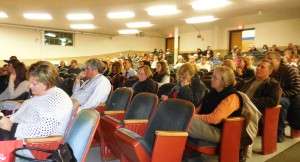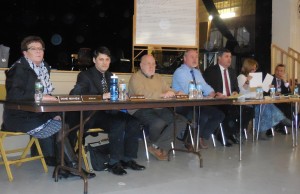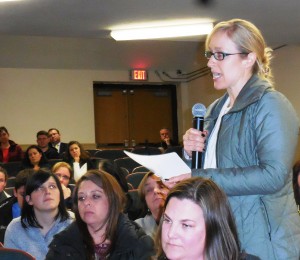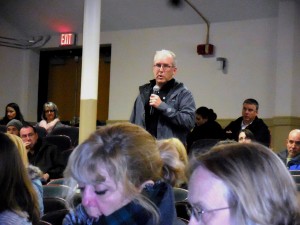WESTFIELD – A scheduled School Committee Finance Sub-Committee meeting to discuss options for the FY18 budget drew an estimated 200 parents, district staff and officials to the auditorium of Westfield Technical Academy on Tuesday evening. The meeting resulted from an initial discussion of the district’s FY18 budget at the sub-committee meeting last week, when it was revealed that $2.9 million more would be needed to provide the same level of services as in FY17.
At Tuesday’s meeting, Kevin Sullivan, chair of the Finance Sub-Committee and members Cynthia Sullivan and Ramon Diaz, Jr. were joined by Mayor Brian P. Sullivan, Superintendent Stefan Czaporowski and the entire School Committee to present seven options for the district, only one of which included keeping Russell Elementary School open.
Kevin Sullivan introduced the topic by recapping how the district arrived at this point.
“We knew 2018 was going to be a tough year because of contracts that were negotiated that will see savings – not this year, but in following years,” Sullivan said. He said the needs have not changed, and Abner Gibbs and Franklin Avenue are schools that need to be retired.
“What has changed; we’re not going to see a new school for several years. Make no mistake, we need a new school,” Sullivan said, adding, “The underlying issue is doing what is best for our students.”
Cynthia Sullivan thanked everybody for coming to the meeting. She said the School Committee has known about the issues in the older schools for a long time, and had planned ahead by planning a new school. She said now with the recent Supreme Judicial Court decision to hear the appeal, it could take another two to five years.
“We can’t control the court system,” Cynthia Sullivan said. She said the budget discussion shouldn’t be only about closing Russell, or about teacher’s wages.
“We are trying to do what is best for every student in Westfield,” she said.
Diaz said he had spent the weekend on the Department of Elementary and Secondary Education (DESE) website, looking at how Westfield compares to the 351 districts in the state. Diaz said Westfield is #40 in student population, #223 in per pupil expenditures, and #46 in total expenditures, “which means six districts with fewer students spend more than us. We are being fiscally responsible,” he said. Later in the meeting Diaz added that Westfield is also #6 in area (46 square miles), which has an impact on busing costs.
“I’m looking at it very closely. I have two kids in the school system,” Diaz said.
“While redistricting is on the table, we have to look at what we can do to have both our middle schools have equal opportunities for the kids,” Cynthia Sullivan added.
Czaporowski then thanked everyone for coming, saying he wanted to start the budget process early, and thanking the Mayor for working with them on it. He said there are many options to reduce the budget including reducing teachers and staff through attrition which would impact class size. He also noted that not one student in Russell Elementary will now see the new school.
He also said he would like to reduce the number of options by the end of the meeting after hearing from the public. ”We hope to narrow down options to two or three,” Czaporowski said.
Option 1: Russell Elementary Remains Open.
Pros: Stability for students and staff, great physical plant, keeps school community together.
Cons: Almost 200 students (187) students travel out of town.
Option 2: Move Russell Elementary into South Middle School as a School within-a-School. (This option was voted by the sub-committee at the end of the meeting to not recommend to the School Committee.)
Option 3: Distribute the 187 Russell students to other elementary schools.
Pros: Savings of at least $699,764 in staff, rent and utilities. This option could reduce additional staff; provide an opportunity to redeploy the 5 buses on the C-run. All students would attend a school in Westfield.
Cons: Requires redistricting of all elementary schools; may impact transportation; may be tight in some schools; would create layoffs; breaks up an established school.
Option 4: Redistrict Franklin Ave. and Highland to K-4 schools and make South Middle School a 5-8 school. (This option was voted by sub-committee not to recommend to full School Committee.)
Option 5: Redistrict the City to six-K-4 elementary schools and two 5-8 middle schools.
Pros: Saves at least $699,764. Increases 5th grade learning time by 30 min./day, or 90 hours/year –adds equivalent of almost 15 more days of school; reduces transportation; staff savings, can redistribute staff; at Middle School for 4-years; frees up 20 elementary classroom spaces; may be able to consolidate 19 classes into 17.
Cons: Large middle schools, (North Middle School=897 and SMS=747); 150-student-difference between middle schools; would require redistricting of middle schools to balance; would create layoffs; parent concerns with fifth graders at middle school.
Option 6: Redistrict to six K-4 elementary schools, to one 5/6 intermediate school, and one 7/8 middle school.
Pros: Saves at least $699,764. Increases 5th grade learning time by 30 min./day, or 90 hours/year which adds equivalent of almost 15 more days of school; balances population at middle schools (823 to 820); frees up 20 elementary classrooms; may be able to consolidate 19 classes into 17.
Cons: Additional transition at a critical time; short stay (2-yrs) at two schools. Increases transportation costs city-wide to both schools as just about every student would be bused to NMS. Need to bus 337 additional students on 7 buses; would create layoffs.
Option 7: Redistrict to six K-4 elementary schools, two 5-7 middle schools and two 8-12 high schools. (This option was voted by sub-committee not to recommend to the full School Committee, because Westfield Technical Academy cannot accept 8th graders.)
“We would save $700,000 by closing Russell. By consolidating the school we would consolidate staff,” Kevin Sullivan said after the options were presented. He said some of the options would come with changing the school day, and others might allow the district to alleviate problems such as unequal distribution of students.
“More kids than we would like would be in new schools,” Sullivan said, adding that all of the options have been done in the city at some point.
“As you can tell, the people up here are pretty passionate about education. Nothing’s off the table. So if you’re thinking of something, take the opportunity to ask it,” Mayor Brian P. Sullivan said, addressing the audience.
“With seven options, we aren’t sure which one makes the most sense. Every option we touch is going to affect someone. One of the reasons Juniper Park moved to Russell is that this group didn’t want to redistrict multiple times. They wanted to move them back into a new school,” the Mayor added.
Comments from the audience centered on several main themes: Keeping Russell Elementary open, ensuring that redistribution would not just affect one school population or one section of the city, concerns about moving fifth graders in with eighth graders, the needs in the high school, and the cost and wisdom of pursuing the elementary school building project.
Several families whose children are enrolled at Russell Elementary sung its praises.
“Russell is phenomenal. If you tell me that no other school than Russell is impacted, it’s heartbreaking,” said Jen McMahon.
“We have four children heavily invested in the Russell School. They have the best teachers. My question is; why didn’t property taxes go up?” asked Heather Dunphy.
“Has our city considered negotiating with Russell for a better price?” asked John Bowen.
Diaz responded to Bowen’s question, by noting that the lease for the Russell school is $250,000, the same amount the city was paying to Westfield State University for the Juniper Park School (which closed in July, 2015, relocating the students to Russell.)
“Mr. (Ronald) Rix did a very good job of negotiating. We do have a good lease with Russell,” Diaz said.
Michele Douglas, one of the leaders of Westfield Special Education Parent Advisory Council (SEPAC), said she thought that Option 6 which added an additional school transition for students would be hard on the kids.
“I’m going to be honest with you, getting fifth grade out of elementary school frightens me,” Douglas said, adding that the transitions affect special education students even harder.
“First off, regarding the options, any that does not impact all elementary schools should be taken off the table. Fifth graders don’t belong with eighth graders. I think option 6 is the best option for every individual developmentally,” said resident Ken McCrary.
“As much as we want this new school, we’re spending so much money to hold onto the dream. Why don’t we scrap it, as frustrating as it is,” McCrary added.
Another resident asked why every other town has newer and better equipment for sports. He also asked whether the roof at the high school gymnasium had been fixed.
Kevin Sullivan responded that the Massachusetts School Building Authority (MSBA) came to the high school a couple of years ago, but the high school is not on their list. “I would love to tell you we have this much more money for sport equipment. The money is not there,” he said.
Mayor Sullivan explained that every year the MSBA asks every community for a list of their needs. “Seven years ago our number one priority was a new elementary school. Number two was a new high school. They (MSBA) are the major funders. They said we don’t need a new high school, it needs refurbishing,” the Mayor said. “We’re stuck in a process. The roof was leaking; we put a band aid on it. The roof on the gymnasium would cost $500,000.”
“The MSBA approved an elementary school for $36 million. That is the priority number one that quite honestly, we can’t get out of the courts,” he said, adding, “We should be in a new elementary school, talking about the new high school.”
Czaporowski said a lot of the school districts with new high schools have elementary schools that are falling apart, including nearby unnamed communities.
Resident Matthew Emmershy thanked the Mayor for holding the line on spending. “Obviously, the spending needs to be controlled. I have one child at Abner Gibbs who will be affected, and another going into school. If it comes down to redistricting, so be it,” Emmershy said, adding, “I haven’t heard talk of cutting the administration. We should buckle down and focus on the administrative side of things.”
“All of those options are being looked at, everything is on the table,” Czaporowski said.
Another resident stood up, summing up many of the opinions voiced in the two-hour meeting. “My biggest concern is that we make it equally work out for everybody. Schools need to have the same ratios, and classrooms of the same size. Let’s make it equal across the city. This is going to be hard and we’re going to have to work together.”
Kevin Sullivan closed the meeting by saying these issues won’t be discussed at next Monday’s (Jan. 23) School Committee meeting, which is the annual joint meeting with the Westfield Technical Academy’s Advisory Committee at the school. He said he will be setting up another Finance Sub-Committee meeting to discuss the issues and would let the public know the date and time.





